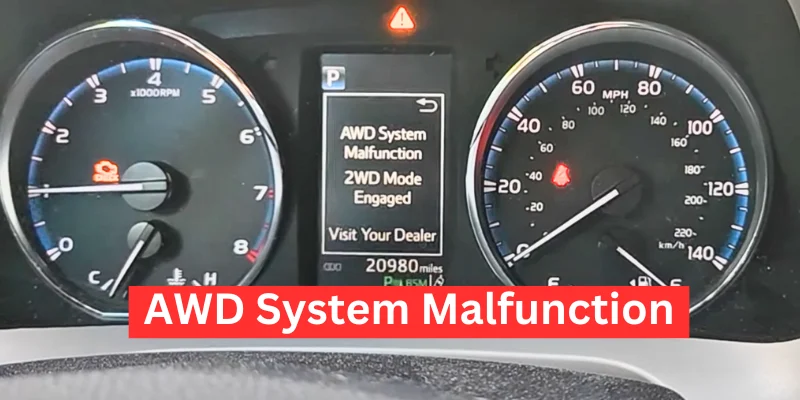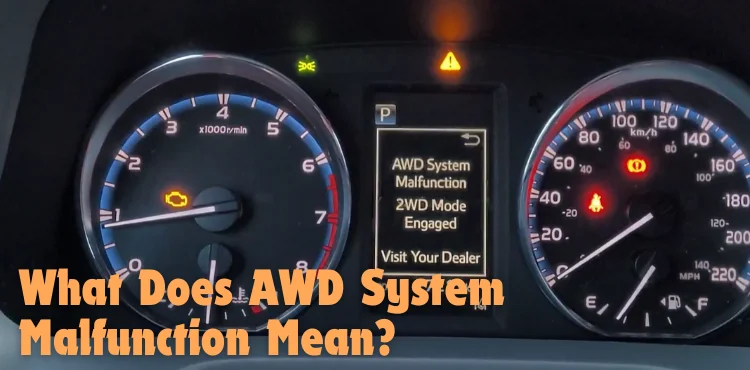AWD System Malfunction: Causes, Fixes, and Model-Specific Insights
Updated: 14 Sep 2024
292
Hey there, are you wondering how to find the answer to “AWD System Malfunction,” a message that appeared on your vehicle’s dashboard?
What if I told you the exact three steps to troubleshoot this malfunction? It would be amazing, right?
So here in this article, I will walk you through what you need to know about this alarming warning, especially when it forces your car into 2WD mode, reducing its ability to handle slippery or rough roads.
What’s more? I have sealed experts’ ways to troubleshoot it and, even more, the model-specific insights into Toyota and Lexus vehicles that commonly face this issue.

What is an AWD System, and How Does it Work?
Before proceeding, let me tell you that an AWD system facilitates driving on all four wheels by distributing the power to all four wheels. It is purposefully designed to improve traction on non-flexible and slippery roads.
What will your vehicle get with AWD? More stability and control, especially in difficult driving conditions.
So, you got me AWD systems to enhance your safety and performance while driving in unusual conditions.
What Does AWD System Malfunction Mean?

Now you see, the AWD system is for your safety. It circulates the power among wheels to maintain better control over inflexible roads. So, a malfunction of this system certainly causes a problem with the vehicle’s stability and a loss of control over the wheels during driving.
So, how does this malfunction come as a warning sign? When the all-wheel-drive function gets disabled due to a disruption in the AWD system, the wheels’ functioning is disturbed. The vehicle automatically shifts to 2WD mode to avoid further damage to the system.
Watch this quick video to see common AWD system malfunctions explained and learn how to troubleshoot them effectively!
How to Fix AWD System Malfunction
Here comes the most valuable section that I trust answers what you were looking for; see the expert’s troubleshooting tips for AWD breakdown:
- Restart the vehicle → Sometimes, a simple reset can fix the issue.
- Check the transmission fluid→. Low or dirty fluid can be a significant cause of AWD problems.
- Secure the gas cap→For Toyota RAV4 owners, a loose gas cap is a common cause of AWD malfunctions.
Common Causes of AWD Malfunctions:
When I sit with my adventurous friends who have been dealing with Rav4 for decades, we usually discuss ways to avoid these malfunctions, and to my surprise, we end up discussing the causes of these malfunctions.
Do you know why? Knowing the causes and avoiding them to the last inch of the world could better facilitate the avoidance of this malfunction, especially when it’s due to a driver’s mistake.
- Electrical problems could be faulty wiring or vehicle computer system issues.
- Sensor malfunctions are when the AWD system relies on sensors that can fail over time.
- Transmission fluid issues that lead to low or contaminated transmission fluid can affect the AWD system’s performance.
- A loose gas cap on the Toyota RAV4 could also cause an AWD defect, which can trigger this warning.
AWD System Malfunction in Popular Models
Now, most users ask about AWD systems when they go wrong in their vehicles, so this thoroughly researched information could answer such concerns; see if you are among the ones:

Toyota RAV4 AWD System Malfunction
For 2017 to 2019 RAV4 models, check:
- For loose gas caps
- Ensuring that fluid levels are correct
- Consulting the Toyota dealership if the breakdown persists
It is often enough to fix the issue.
Lexus AWD System Malfunction (RX 350, NX200t)
For Lexus owners, the most common fixes include:
- Resetting the system
- Addressing sensor issues
Note: These models are highly vulnerable to electrical faults, so a professional mechanic might be needed to troubleshoot.
Other Toyota Models (Highlander, Sienna, CH-R)
These vehicles may also experience AWD issues due to sensor malfunctions or low transmission fluid. Following general maintenance recommendations, such as fluid checks, can help prevent future issues.
FAQs for AWD System Malfunction and 2WD Mode Engaged
What is 2WD Mode Engaged?
Whenever a malfunction is detected in the vehicle, its AWD system automatically shifts it to disabled mode and into 2WD mode. This process reduces the vehicle’s burden and assists in handling difficult conditions.
What breakdowns different models’ experiences for AWD systems?
Toyota RAV4 (2016-2019) models frequently experience 2WD mode engagement due to loose gas caps or sensor issues, while the Lexus Models (RX350, NX200t) may experience 2WD engagement if sensors malfunction, particularly after rough road conditions.
When to visit the professional dealership?
If your vehicle stays in 2WD mode after attempting basic troubleshooting, it’s time to visit your dealer. More complicated issues like sensor or transmission failures require professional diagnosis and repair.
What are the experts’ recommended preventive measures for AWD Systems?
Here you go with a few preventive measures for your vehicle’s AWD system:
Regular Fluid Checks:
- Per the manufacturer’s guidelines, ensure that transmission and differential fluids are regularly topped up and replaced.
Maintaining Sensor Health:
- AWD systems rely heavily on sensors. Make sure they are regularly checked and replaced if necessary.
Why does my AWD system malfunction cause my car to enter 2WD mode?
This is a safety measure to prevent further damage to the AWD system.
How can I fix the AWD system malfunction in your Lexus?
Reset the system, check sensors, or visit a mechanic if the problem persists.
Can I drive my vehicle in 2WD mode while waiting to fix the AWD system?
Yes, but exercise caution, especially in challenging road conditions like snow or rain.
Conclusion:
So, I trust all your frustrations with AWD system malfunctions will no longer be with you.
Now you know that this breakdown is manageable with a few expert’s advice.
The last reminder for you is to stay aware of the warning signs, causes, and fixes for these malfunctions. That’s the key to keeping your vehicle running smoothly.
Don’t forget that regular maintenance, such as checking transmission fluid and ensuring sensor health, can help prevent these issues.
Let us know if you need further assistance with the malfunctions of the AWD system.
Please Write Your Comments